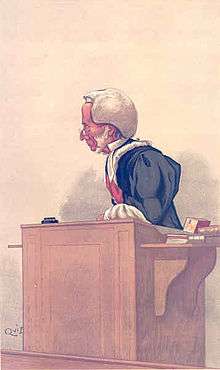Henry Manisty
Sir Henry Manisty (1808–1890) was an English barrister and judge.

Life
The second son of James Manisty, B.D., vicar of Edlingham, Northumberland, and his wife Eleanor, only daughter of Francis Foster of Seaton Barn Hall, Northumberland, he was born 13 December 1808. He was educated at Durham Cathedral grammar school, and was articled when still young in the offices of Thorpe & Dickson, attorneys, of Alnwick, Northumberland.[1]
Manisty was admitted a solicitor in 1830, and practised for twelve years as a member of the firm of Meggison, Pringle, & Manisty, of 3 King's Road, London. On 20 April 1812 he became a student of Gray's Inn, and he was called to the bar 23 April 1816. He became a bencher there in 1859, and treasurer in 1861.[1]
Joining the northern circuit, Manisty obtained a practice, and was made Queen's Counsel 7 July 1857; he appeared mainly in mercantile and circuit cases. In November 1876, when Lord Blackburn left the High Court, he was made a judge, and was knighted. Among his decisions were judgments in Regina v. Bishop of Oxford (1879), Belt v. Lawes (1881), Adams v. Coleridge (1891),Wennhak v Morgan[2] and O'Brien v. Lord Salisbury (1889).[1]
Manisty was seized with paralysis in court 31 January 1890, died 30 January at 24a Bryanston Square, London, and was buried, 5 February, at Kensal Green cemetery.[1]
Family
In August 1831 Manisty married Constantia, fifth daughter of Patrick Dickson, solicitor of Berwick-on-Tweed, who died 9 August 1836; and in May 1838 Mary Ann, third daughter of Robert Stevenson, surgeon, of Berwick-on-Tweed, with whom he had four sons and three daughters.[1]
Notes
- 1 2 3 4 5
 Lee, Sidney, ed. (1893). "Manisty, Henry". Dictionary of National Biography. 36. London: Smith, Elder & Co.
Lee, Sidney, ed. (1893). "Manisty, Henry". Dictionary of National Biography. 36. London: Smith, Elder & Co. - ↑ Wennhak v Morgan (1888) 20 QBD 635 at 639.
Attribution
![]() This article incorporates text from a publication now in the public domain: Lee, Sidney, ed. (1893). "Manisty, Henry". Dictionary of National Biography. 36. London: Smith, Elder & Co.
This article incorporates text from a publication now in the public domain: Lee, Sidney, ed. (1893). "Manisty, Henry". Dictionary of National Biography. 36. London: Smith, Elder & Co.